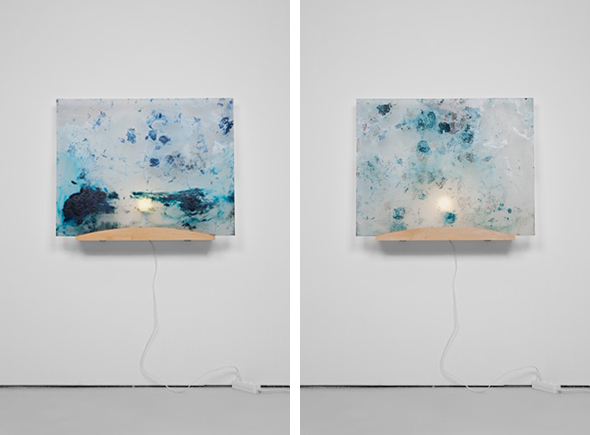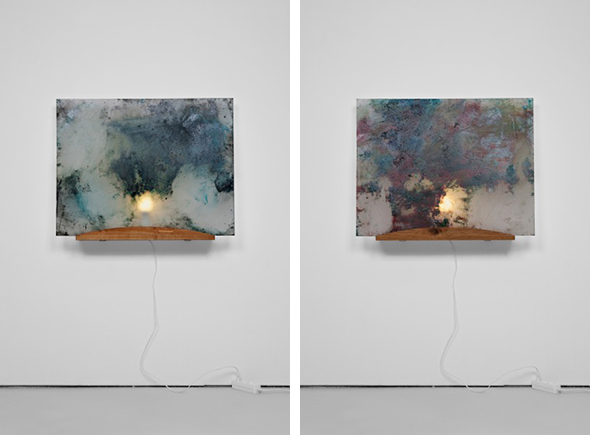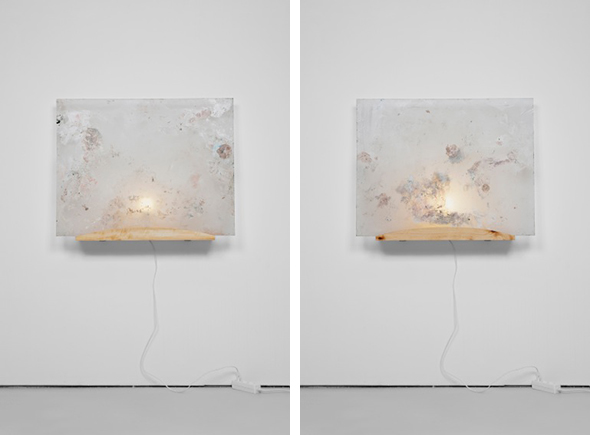Article by Axel Andersson; Thursday, Apr. 04, 2013
The Norwegian artist Fredrik Værslev invites the spectator to look, and then look again with seven works at Circus gallery. There is a wealth of references superimposed on what, for being both paintings and sculptures, are painstakingly minimalist objects. Ostensibly the subject matter is the landscape and Værslev returns to this depleted genre in order to imbue it with new meaning. The works all consist of frosted acrylic glass mounted on a wooden support with a light bulb behind. The glass has been painted and then de-painted with an ice scraper. What remains are abstractions ranging from mere smudges to hints of grander Turner-esque scenes.
 “Untitled (Landscape: Blue and Landscape: Turquoise #5)” (2013), spray paint, matte transparent spray and glossy transparent spray on frosted acrylic glass, wooden support (maple), bulb socket, light bulb, electric cable, 72,5 x 90 x 17 cm; courtesy the artist and Circus, Berlin
“Untitled (Landscape: Blue and Landscape: Turquoise #5)” (2013), spray paint, matte transparent spray and glossy transparent spray on frosted acrylic glass, wooden support (maple), bulb socket, light bulb, electric cable, 72,5 x 90 x 17 cm; courtesy the artist and Circus, Berlin
The landscape is both the frame and the content as though the view has attached itself to the surface. The effect is similar to that of stained glass windows found in churches. These are frames that also give content. They differ from classical paintings in that they readily accept an outside support that puts the scene in motion. Rather than merely representing the image as a self-contained universe they ambitiously seek to represent the process of seeing and of staging. In Værslev’s case it is the light in the background that momentarily disorients perception. The placing of the light bulbs are reminiscent of the lights at the edge of a theatre stage, but here they penetrate from the background. It is as though the works are rudimentary television sets, or, more in keeping with their matter-of-fact minimalism, a view of a house with light seeping from frosted windows as we stand on a dark winter’s night looking in.
 “Untitled (Landscape: Black #1 and Landscape: Green #2)” (2013), spray paint, matte transparent spray and glossy transparent spray on frosted acrylic glass, wooden support (maple), bulb socket, light bulb, electric cable, 72,5 x 90 x 17 cm; courtesy the artist and Circus, Berlin
“Untitled (Landscape: Black #1 and Landscape: Green #2)” (2013), spray paint, matte transparent spray and glossy transparent spray on frosted acrylic glass, wooden support (maple), bulb socket, light bulb, electric cable, 72,5 x 90 x 17 cm; courtesy the artist and Circus, Berlin
Outside and inside take turns changing places, references to stained glass inside a church give over to an external view: looking at a window from the point of view of nature. In a seemingly simple manoeuvre Værslev manages to question the construction of the medium. These are works that look at us every bit as much as we look at them. So where is the landscape? You’re tempted to turn around and look over your shoulder, but the reality is more complex. It is as though nature has stayed on the retina in the same way as the glow of a lamp lingers after we have closed our eyes. The visual surface is transformed into a visceral affect. What was an exterior landscape becomes an interior impression. Værslev is evidently not seeking to question the relationship between representation and reality, but addresses instead the connection between representation and the subject.
 “Untitled (Landscape: White #4 and Landscape: White #1)” (2013), spray paint, matte transparent spray and glossy transparent spray on frosted acrylic glass, wooden support (maple), bulb socket, light bulb, electric cable, 72,5 x 90 x 17 cm; courtesy the artist and Circus, Berlin
“Untitled (Landscape: White #4 and Landscape: White #1)” (2013), spray paint, matte transparent spray and glossy transparent spray on frosted acrylic glass, wooden support (maple), bulb socket, light bulb, electric cable, 72,5 x 90 x 17 cm; courtesy the artist and Circus, Berlin
It is only fitting that Værslev also references his own background in this play of subjectivity and representation. Norway is present not only as the idea of a “natural” landscape, but also in the wooden supports (all deciduous leaf trees). This wood, like birch and oak, does not merely connect the works to “nature”. There is also something vaguely reminiscent of carpentry and the inside of a house. The vantage point of the spectator is again put in doubt. The “inside” can also be taken to mean “culture” and it is possible to trace decidedly cultural references in the works. The great Norwegian painter Edvard Munch got, as the curatorial text reminds us, inspiration from how artificial light was used in theatre stages to illuminate the actors and scenery flats containing painted landscapes. It was also on those Norwegian theatre stages that Henrik Ibsen had already started to experiment with different intensity of lighting for directly allegorical effect, for example to symbolize wealth or poverty in The Wild Duck from 1884.
The message of the medium in Værslev’s work appears to be an insistent reminder not to forget the very fact that the medium always has a message rather than merely becoming the message itself. He hints enough at various meanings and signs to get his point across, but is then content to let the power of the physicality of the works take over. There is a strange and enthralling intensity to his art that refuses to let go. To be forced to observe the act of observation produces an uncanny effect. Værslev presents a thoroughly conceptual trompe-l’œil.
______________________________________________________________________
Additional Information
CIRCUS
“The World is Your Oyster” – FREDRIK VÆRSLEV
Exhibition: Mar. 16 – Apr. 13, 2013
Obentrautstraße 21 / Haus 17 (click here for map)
___________________________________________________________________________________























